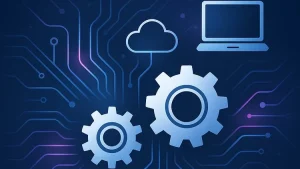AI-Powered Sales Forecasting: A Small Business Superpower You Can Actually Afford

Let’s be honest. For a small business owner, sales forecasting can feel a lot like reading tea leaves. You stare at last month’s spreadsheet, factor in a hunch about the economy, cross your fingers, and hope you’ve ordered enough inventory—or, you know, not too much. It’s stressful. And frankly, it’s a bit archaic.
But what if you had a crystal ball that actually worked? That’s the promise of AI-powered sales forecasting. And before you dismiss it as some expensive, enterprise-level tech, hear me out. This is no longer a tool just for the big players. A quiet revolution is happening, and it’s putting powerful AI insights into the hands of small businesses just like yours.
What Exactly Is AI-Powered Sales Forecasting?
In simple terms, it’s using artificial intelligence to predict your future sales. But it’s so much more than just a fancy trend line on a graph. Think of it as your most analytical, data-obsessed employee who never sleeps.
Traditional forecasting often relies on looking at last year’s numbers and making a rough guess. AI, on the other hand, feasts on data. It analyzes a multitude of factors simultaneously—things you might not even think are connected.
We’re talking about:
- Your historical sales data (of course).
- Website traffic and user behavior.
- Local weather patterns (crucial for businesses like cafes or landscaping).
- Social media sentiment and local events.
- Even broader economic indicators.
The AI finds the hidden patterns in this chaos. It learns that, say, a 3-degree temperature drop and a positive local news story typically lead to a 15% spike in your soup sales. It’s that specific. That intelligent.
Why Bother? The Tangible Benefits for Your Bottom Line
Okay, so it sounds smart. But what does it actually do for you? Well, the shift from guessing to knowing changes everything.
Smarter Inventory Management
This is a huge one. Overstocking ties up your precious cash in sitting inventory. Understocking means lost sales and disappointed customers. AI forecasting helps you hit the Goldilocks zone—just right. You’ll order what you need, when you need it, freeing up capital and keeping your shelves optimally stocked.
Sharper Budgeting and Cash Flow Clarity
When you have a reliable prediction of future revenue, you can stop sweating the financial stuff. You can make confident decisions about hiring, marketing spend, and new equipment investments. You’re no longer flying blind. You’re navigating with a detailed map.
Proactive Strategy, Not Reactive Panic
Imagine your AI model flags a predicted sales dip for two months from now. Instead of being surprised and scrambling, you can get ahead of it. You could launch a targeted promotion, ramp up your social media ads, or run a special event to counteract the slump. You move from being a passenger to the pilot of your business.
Getting Started: It’s Less Scary Than You Think
I know, I know. The term “AI implementation” can sound like a months-long, budget-busting IT project. But for small businesses, it doesn’t have to be. Here’s the deal: you don’t need a team of data scientists.
Many of the tools you might already be using are baking AI right into their platforms. Here’s a quick look at some common entry points:
| Tool Category | How It Uses AI for Forecasting |
| CRM Platforms (e.g., Salesforce, HubSpot) | Analyzes your pipeline, deal stages, and historical close rates to predict quarterly revenue. |
| E-commerce Platforms (e.g., Shopify) | Uses sales history, seasonality, and traffic trends to forecast demand for each product. |
| Accounting Software (e.g., QuickBooks) | Examines your cash flow patterns and invoices to project future financial health. |
| Standalone AI Business Tools | Connect to your data sources (like Square or Stripe) and provide dedicated forecasting dashboards. |
The first step is almost always an audit. Look at the software you already pay for. Dig into the features. You might find a powerful “Analytics” or “Insights” tab you’ve been ignoring. That’s your starting line.
A Real-World Glimpse: How a Boutique Uses AI
Let’s make this concrete. Imagine a local clothing boutique, “The Curated Closet.” The owner, Maria, used to order winter coats based on a gut feeling and last year’s sales. Some years she sold out by November; other years, she was discounting coats well into spring.
She started using her e-commerce platform’s built-in AI demand forecasting. The system didn’t just look at last year. It analyzed:
- Early-fall online browsing data for coat pages.
- The local long-range weather forecast predicting a colder, wetter winter.
- A surge in “wool coat” searches from her city on social media.
The AI recommended she increase her coat order by 22% for specific styles and sizes. She did. And she sold out of her initial stock right on schedule, with just enough extra inventory to meet demand through the holiday rush without a fire sale. Her profit margin on that category increased by 18%. That’s the power of a precise, AI-powered forecast.
The Human Touch: You’re Still the Boss
This is the most important part. AI is a tool, not a replacement for your intuition. The best results come from a partnership. The AI gives you the data-driven prediction—the “what.” You provide the context—the “why.”
Maybe the AI predicts a sales surge, but you know a major competitor is opening across the street. Or it predicts a dip, but you have a brilliant new marketing campaign ready to launch. You layer your human experience, your street-level knowledge, onto the AI’s number-crunching. That combination? That’s unstoppable.
The goal isn’t to create a perfectly autonomous business robot. It’s to arm yourself with the best possible information so you can make the best possible decisions. It’s about working smarter, not just harder.
So, What’s the Future Hold?
We’re just at the beginning. AI is getting more intuitive, more accessible, and frankly, more affordable. The barrier to entry, which was once a massive wall, is now just a small step. This technology is democratizing business intelligence, and that’s a profoundly powerful shift.
The question is no longer if small businesses will use AI, but how quickly they’ll adopt it to stay competitive. The ones who embrace these tools will navigate the unpredictable waves of the market with a sturdier ship and a much, much better compass.
It’s not about having a crystal ball, after all. It’s about finally turning on the lights.







